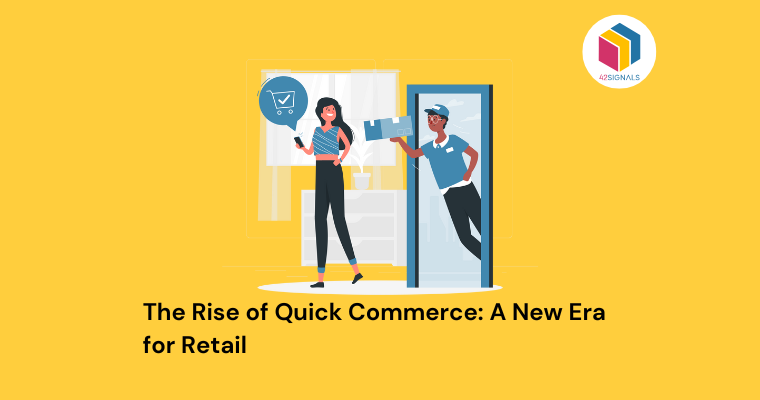Quick commerce also known as Q-commerce or instant delivery, is a new business model that prioritizes speed and convenience above all else, promising customers rapid delivery times ranging from mere minutes to a few hours.
The primary goal of q-commerce is to cater to consumers who desire immediate satisfaction and are willing to pay extra for prompt service. It leverages advanced technologies such as artificial intelligence, machine learning, and data analytics to optimize supply chain management, logistics, and inventory control, ensuring efficient and timely order fulfillment.
By doing so, instant commerce aims at creating a seamless shopping experience where customers receive their orders faster than ever before, ultimately redefining the way businesses operate and meet customer expectations.
While the concept of delivering goods quickly has been around for some time, with examples like pizza delivery or local grocery stores offering same-day delivery, the modern incarnation of q-commerce started gaining traction around 2011-2014.
During this period, several companies began experimenting with technology solutions aimed at providing even faster delivery services, particularly in urban areas. These early pioneers focused mainly on specific product categories, such as groceries and food items, using mobile applications and geolocation features to enable customers to place orders and track their progress in real time.
Since then, q-commerce has continued to evolve, expanding into various markets worldwide and incorporating other product categories beyond perishables. Today, this industry represents a rapidly growing segment of the overall e-commerce market, driven by changing consumer preferences towards convenient, fast, and contactless shopping experiences.
With giants like Amazon and Walmart already investing heavily in this space, it’s safe to say that quick commerce is here to stay – but what does it mean for the future of retail?

Image Source: Delivery Hero
Rise of Quick Commerce in Retail
At its core, q-commerce represents a significant shift away from traditional e-commerce models. While online shopping once promised consumers the ability to browse and purchase products at their leisure, often with free shipping included, today’s shoppers demand more immediate gratification.
For today’s shoppers living a fast-paced lifestyle, time has become a valuable commodity; consequently, many consumers are willing to pay premium prices for faster deliveries.

Image Source: Intelligence Node
This surge in demand for expedited services can be attributed largely to advancements in technology. Mobile apps and web platforms now enable real-time tracking of orders, allowing customers to monitor their purchases every step of the way.
Additionally, innovations such as drones and autonomous vehicles have paved the way for even swifter last-mile delivery solutions. As these technologies continue to improve, we can expect quick commerce to become an increasingly integral part of the retail landscape.
Q-Commerce for Grocery
One industry that stands to benefit significantly from the rise of instant commerce is grocery. Traditionally, supermarkets have relied upon brick-and-mortar stores to serve customer needs. However, with the advent of online grocery shopping and home delivery services, consumers now have access to fresh produce and pantry staples without ever leaving their homes.
Companies like Instacart and Shipt have capitalized on this trend by offering same-day delivery options, further solidifying the appeal of q-commerce within the grocery sector.
Q-Commerce for Logistics

Image Source: Medium
Another area where quick commerce holds immense potential is urban logistics. Given the densely populated nature of cities, delivering goods efficiently and sustainably poses unique challenges. By leveraging micro-fulfillment centers located closer to end customers, instant commerce providers can reduce transportation emissions while simultaneously minimizing delivery times.
This approach not only benefits the environment but also enhances overall customer satisfaction, creating a win-win situation for both businesses and consumers alike.
Challenges in Ensuring Instant Deliveries
Instant commerce isn’t without its drawbacks. For instance, maintaining profitability remains a considerable challenge due to the high operational costs associated with rapid delivery.
Moreover, ensuring product quality during transit – particularly perishable items – presents another obstacle that must be addressed.

Image Source: Shipsy
To ensure that the experience of such orders still remains pleasant, companies will need to invest in robust infrastructure and develop innovative strategies to optimize their supply chains further.
The Upside of Quick Commerce
Despite these challenges, however, the potential upside of q-commerce far outweighs any inherent risks. According to a report by ResearchAndMarkets, the global quick commerce market is projected to reach $35 billion by 2026, growing at a compound annual growth rate (CAGR) of over 47% during the forecast period.
Clearly, there is ample opportunity for retailers who are willing to adapt to this emerging paradigm shift.
So, how should retailers prepare for the rise of instant commerce?
#1 Firstly, they must recognize that speed and convenience are no longer optional features but rather essential components of modern consumer experiences. Embracing digital transformation through mobile applications, real-time order tracking, and automated fulfillment systems will be crucial in staying competitive within this rapidly evolving landscape.
#2 Secondly, a collaboration between retailers and third-party logistics providers (3PLs) specializing in instant commerce may prove beneficial in reducing overhead expenses while improving service quality. Partnerships of this nature could help streamline operations, enhance inventory management, and facilitate seamless integration across various stages of the supply chain.
#3 Lastly, fostering innovation and continuous improvement will be vital in driving long-term success. Adopting cutting-edge technologies such as artificial intelligence (AI), machine learning (ML), and Internet of Things (IoT) devices can provide valuable insights into consumer behavior patterns, enabling personalized recommendations and targeted marketing campaigns.
Conclusion on Quick Commerce
The rise of Q-commerce heralds a new era for retail, characterized by heightened expectations around speed, convenience, and sustainability. With the average number of customers steadily growing month-on-month, instant commerce has become a new way of shopping for most people.
While the industry is just finding its legs and dealing with the challenges of logistics and customer satisfaction, the growth for this industry is poised to be phenomenal. As we move forward, it’ll be fascinating to observe how quickly retail transforms under the influence of instant commerce.
To read more such informative articles, visit our blog or insights page.
Frequently Asked Questions
Which quick commerce is best?
The best quick commerce platform depends on factors like location, product variety, delivery speed, and customer service. Some of the top players in the quick commerce space include:
- Gorillas: Known for ultra-fast grocery delivery (often within 10 minutes) in select cities. They have a well-curated selection of essentials and are popular in Europe.
- Getir: Another popular quick commerce service, Getir operates in many countries and focuses on delivering groceries and convenience items within minutes.
- GoPuff: Primarily available in the U.S., GoPuff delivers snacks, drinks, and household essentials, often in less than 30 minutes.
- Zapp: Popular in major UK cities, Zapp provides superfast delivery, specializing in both groceries and lifestyle products.
- Flink: A Germany-based service known for grocery delivery in minutes, Flink operates in several European cities and offers a wide range of fresh products.
Is Amazon quick commerce?
Amazon is not traditionally considered a “quick commerce” company, but it has ventured into faster delivery services through options like Amazon Prime Now and Amazon Fresh.
- Amazon Prime Now: Offers delivery of groceries, household items, and essentials in as little as 1-2 hours in select locations, which aligns with the quick commerce model.
- Amazon Fresh: Focuses on grocery delivery, usually offering same-day or next-day delivery, but in some areas, this service is approaching quick commerce speeds.
While Amazon’s standard model focuses on e-commerce with same-day, next-day, or two-day delivery, it is increasingly offering services that compete with quick commerce platforms for ultra-fast delivery.
What is the difference between e-commerce and quick commerce?
The primary difference between e-commerce and quick commerce lies in the speed of delivery and the types of products offered:
- E-commerce: Typically refers to the online buying and selling of products or services, with delivery times ranging from a few days to a week. E-commerce platforms like Amazon, eBay, or Shopify offer a broad selection of items, from electronics to apparel, but deliveries are usually not immediate.
- Quick Commerce (q-commerce): Focuses on the rapid delivery of essentials, such as groceries, snacks, and household items, often within 10-30 minutes. It serves immediate needs and is heavily reliant on local fulfillment centers to ensure ultra-fast delivery. Companies like Gorillas, Getir, and GoPuff exemplify quick commerce by prioritizing speed and convenience for time-sensitive purchases.
In summary, while e-commerce is designed for general online shopping with longer delivery times, quick commerce emphasizes immediate, short-distance deliveries of everyday necessities.




